Do you want to start to keep and care for your first pet tarantula? This page will discuss the basics of keeping and caring for tarantulas. Although tarantulas are strange, bizarre crawlers, their care is quite easy, as you’ll find out. Some species are more challenging to keep and be more for the experienced bug enthusiast. Others are easier to take care of and are perfect for when you just begin keeping tarantulas.
We’ll discuss topics like housing, set up the right environment, feeding your tarantula, cleaning the enclosure and about the handling of your pet spider. Prepare yourself to be a tarantula keeper! Let’s dive in.
Housing – basic setup for tarantulas
When selecting an appropriate enclosure setup for your tarantula, you’ll need to keep the species in mind. There are broadly three types of tarantulas species: terrestrial species (living mostly on the bottom), fossorial species (mainly living in their burrow) and arboreal species (living primarily in trees and branches).
Another critical point to consider is knowing where to place your new tarantula enclosure. The location of the enclosure should meet the following features:
- The enclosure should never be placed in direct sunlight. Tarantulas don’t like direct sunlight, and the enclosure could overheat quite fast.
- Tarantulas can become very stressed when the enclosure is placed in a location with a lot of disturbance. Think of a location nearby a television, stereo speakers, or when kids are running along frequently. Tarantulas can pick up vibration really well (one of their best-developed senses), so with a lot of sounds or physical vibration will stress out your tarantula.
- Make sure the enclosure is placed stable and is unable to fall off from a considerable height.
- With free-roaming pets, such as cat and dogs, make sure your loving pet is unable to knock over, broke into, or reach to your pet tarantula in any other way.
- Are you a smoker? Not a problem, except that tarantulas can’t handle nicotines. Nicotine has strong insecticide features — don’t smoke near your tarantula and make sure the room is well ventilated where you keep your crawler.
When you have found the perfect spot to place your tarantula enclosure, it is time to pick a proper enclosure.
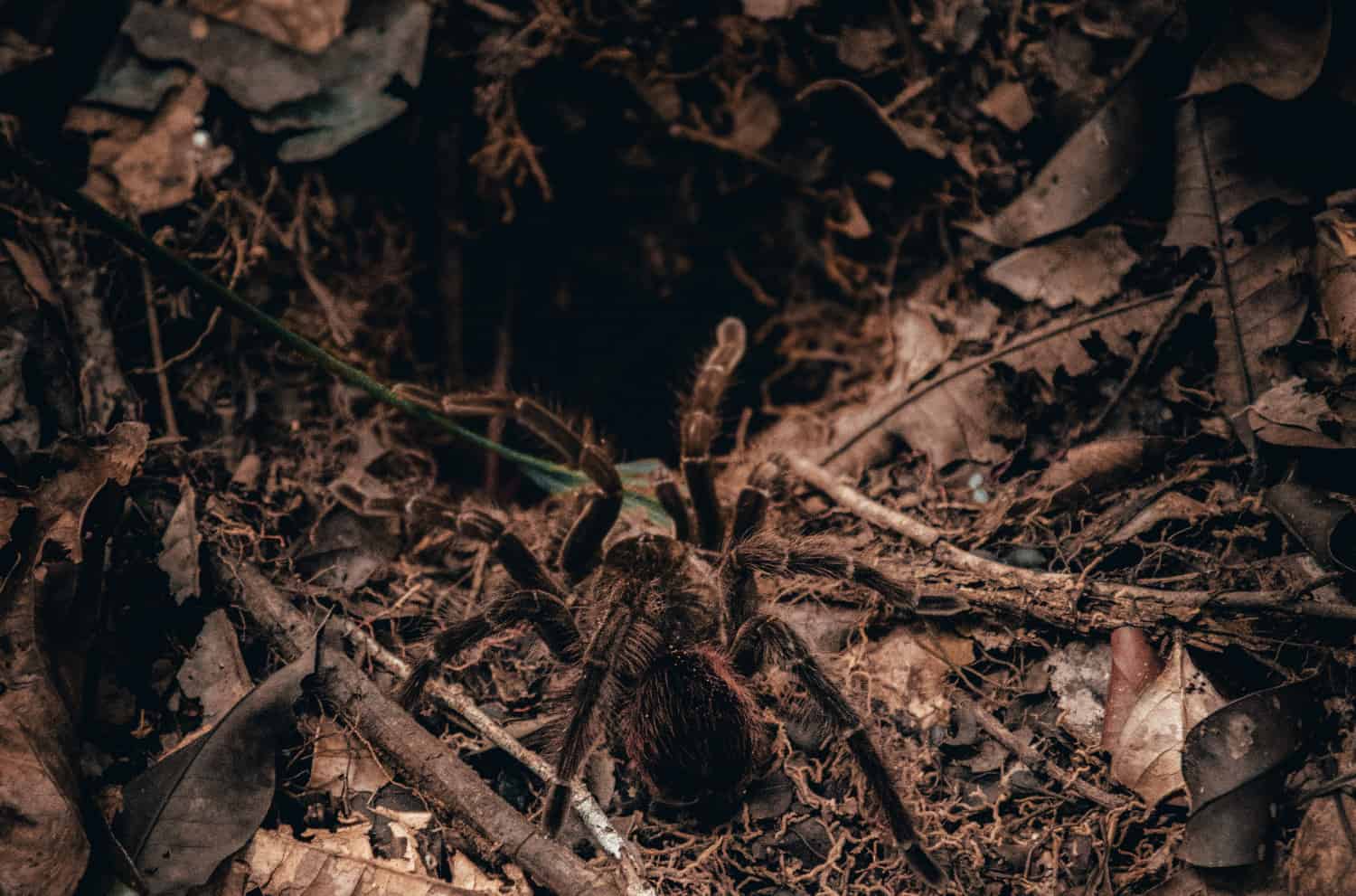
Enclosure types and enclosure size
There are different enclosures available that are great to house your tarantula. Although you can let your tarantula walk freely, it will absolutely be better to house them in a contained space. Tarantulas are quite fragile actually. They need proper substrate, temperature, humidity, and it needs to be safe, to keep them healthy and alive.
Fortunately, they don’t need a very large enclosure. It even seems that they do better and like it more in a smaller enclosure. They mostly live in their burrow/hiding place and not move more than 10 cm, so small spaces are perfectly acceptable for them. Let’s look at different types of enclosures/tanks that are suitable to keep in tarantulas.
- Glass tank — Brands like ‘Exo Terra, Repti Zoo and Zoo Med’ have a variety of enclosures suitable for tarantulas, also for arboreal species.
- Aquarium tank — aquarium tanks are suitable for terrestrial and fossorial species, but you’ll need to make your own lid or adjust the current lid to provide enough ventilation.
- Plastic tank — often sold as a ‘Critter/Kritter keeper’, ‘Herphaven’ or ‘Faunarium’. These enclosures are more suitable for terrestrial species and smaller tarantulas.
- Acrylic tank — These enclosures make good visibility to your tarantula. They are perfect for housing spiderlings and smaller tarantulas, and some higher variants are very useful for (smaller) arboreal species.
- Plastic container — Plastic stack boxes are easy to convert to tarantula enclosure, are easy to adapt and cheap to buy. These are also useful as a back-up container. Deli cups are useful for housing spiderlings and baby spiders.
- DIY build tank — If you are handy you can build your own tarantula tank. You can decide your own sizes and the amount of ventilation (holes) and where the opening(s) come.
The size needed to house your tarantula, of course, depends on the species. But there is one crucial difference. Where terrestrial and fossorial species need more ground space, arboreal species need more vertical space.
For terrestrial/fossorial tarantulas you’ll need a tank that has a size of at least three times the leg span across, and two times the leg span in height would be sufficient. Don’t pick a tank that is much higher, because when these tarantulas climb and fall can get hurt and injured. If you like you can have a (much) larger enclosure than three times their leg span. Make sure that with these species you have a tank that is opened from the top (especially with burrowing/fossorial species).
For arboreal tarantulas, you’ll need a higher enclosure, where vertical space is more important than surface space. For these species, it would be good to have a front door instead of a top-door because many of them like to web on their ceilings and when opening from the top will disturb the spider and destroy the webbing continuously.
Ventilation
Make sure that your enclosure comes with ventilation, and when missing, create ventilation. Many tanks have pre-built ventilation strips or holes. Be thoughtful that over time a tarantula can chew through the fine metal gauze. When you need to make (additional) ventilation, like in a plastic container, you can drill many small holes. That way you don’t have to cover them with gauze or anything without the chance that they chew through it.
Even when you’ll need high humidity in your enclosure, always make sure there is enough ventilation. Stagnant air can contribute, especially in humid environments, to the growth of mould, which in turn is lethal to your tarantula.
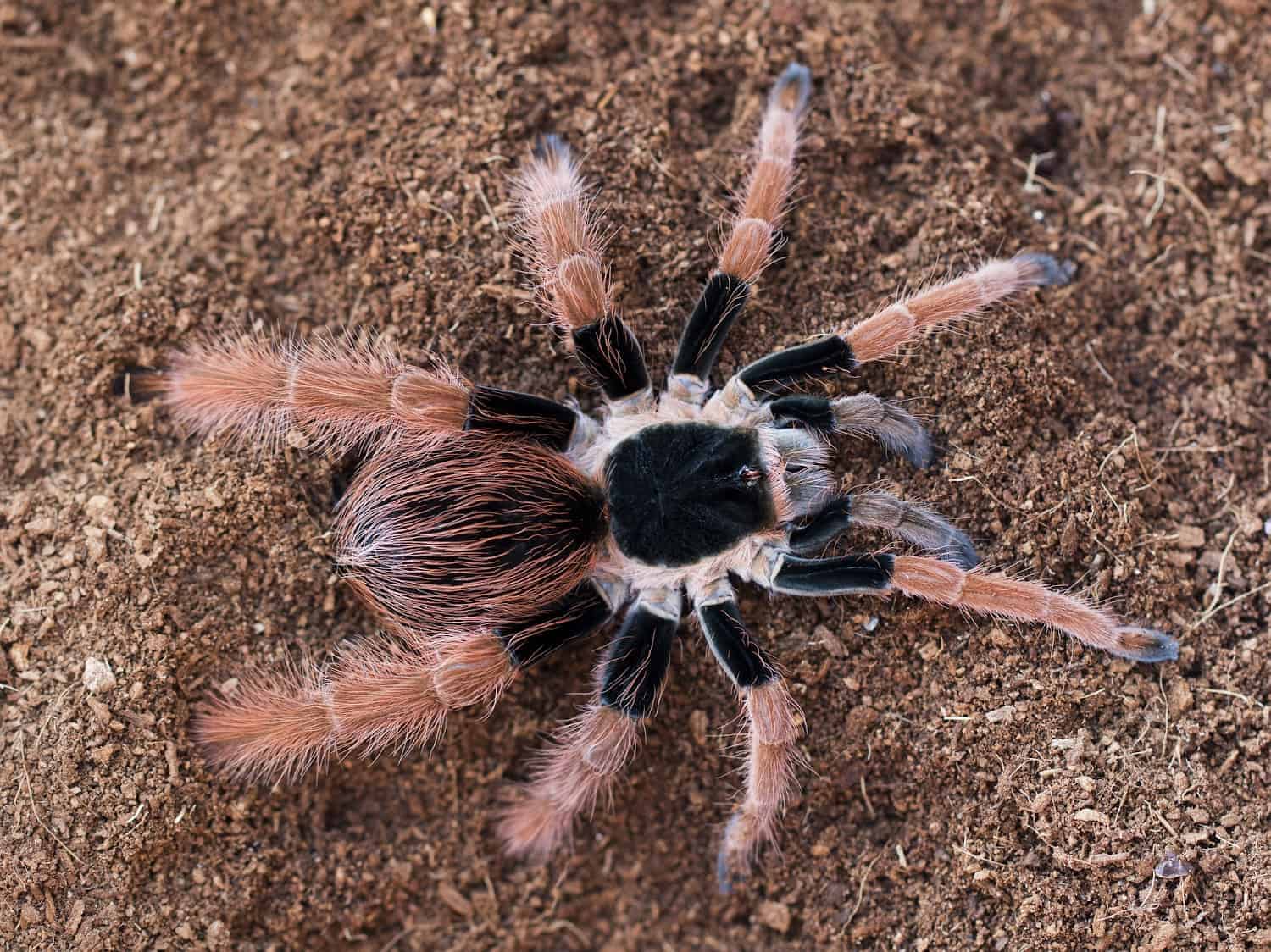
Substrate
The substrate is a key feature in your tarantula tank. It holds moisture and creates a steady humidity. It also provides the possibility for spiders to dig (for fossorial species a must-have!).
The best material to use as a substrate is coco fibre. It is often sold under other names such as ‘Terrarium humus, Eco Earth, and Terra Tarantula’. It comes in blocks, and you’ll need to add water to it which make it expand into a usable substrate. You can mix in vermiculite if you want a more humid substrate for species that require higher humidity. Some species need a dry environment, and this can be achieved by mixing sand to the coconut fibre. Of course, there are several types of substrate you can use, but in my experience coco fibre works really well. Whatever you choose, make sure the substrate is free of fertilizer, additives and chemicals.
A layer of 7cm up to 10cm (3″-4″) is ideal for most terrestrial species. Fossorial species need much more substrate for burrowing. A substrate layer of at least 20cm (8″) is required for them to can comfortably digging in. Arboreal species don’t need much of a substrate, and a layer of 5cm (2″) is perfect for tree-dwelling species.
Furniture and decoration
There are only two essential furnishing items you’ll need to add to your tarantula habitat: A hiding place and a drinking bowl.
You’ll need to create a hiding place for your tarantula. Tarantulas are essentially nocturnal and prefer a dark shelter to hide during lighting hours. You can make a shelter of commercially available products, cork bark piece/tube or use a flower pot cut in half. The cork bark and some of the commercially available products look more naturalistic if that is something you are aiming for. For your spider, it does not matter. Often they will dig in and around your provided shelter and web the walls of their burrow to make it stable and easier to climb in or out. Fossorial species often dig their own hiding place, but also to them you can provide the first entrance of a burrow.
Additionally for arboreal spiders, you’ll need to provide some climbing structure too. A piece of cork bark/tube, or a branch will be sufficient, but make sure it has some option to choose where to sit or a place to hide behind (artificial plant works well for this purpose). Do not immediately run off and pick up a tree branch from your garden. Such a branch can contain parasites or other harmful insects. It is better to buy clean or fake ones at a pet store. You can also put the branch in the freezer for several (5) days to kill parasites, bacteria and insects. Make sure the branch does not contain any pesticides because a freezer does not make pesticides go away.
Tarantulas need a water bowl for drinking water. You can use many types of water bowls, such as plastic bottle caps, plastic jars or small deli containers. There are some commercial water bowls available (often sold for reptiles) that have a large benefit for not falling over that easily. They have a larger surface, and you’ll get a more shallow layer of water. A water bowl also helps to keep the humidity stable. A drinking bowl needs at least to be refreshed every three days, or when all water is evaporated.
ATTENTION: ‘Water crystals’ and ‘bug gel’ products in the pet trade don’t make a good water source for tarantulas and should be avoided to use for drinking water for your spider.
When you like a more natural look of your tarantula habitat, you can use all kinds of natural and artificial materials like artificial plants, bark, moss, live plants. Make sure it does not take up too much floor space. Also, avoid adding sharp objects (like sharp rocks) that can potentially harm or injure your spider.
Back-up containers
I can highly recommend having at least one backup container as an additional holding tank available. When you need to clean the enclosure, need to rehouse your spider, or when your primary enclosure breaks (i.e. cover lock), you can make sure you have a container to (temporary) keep your spider safely and well.
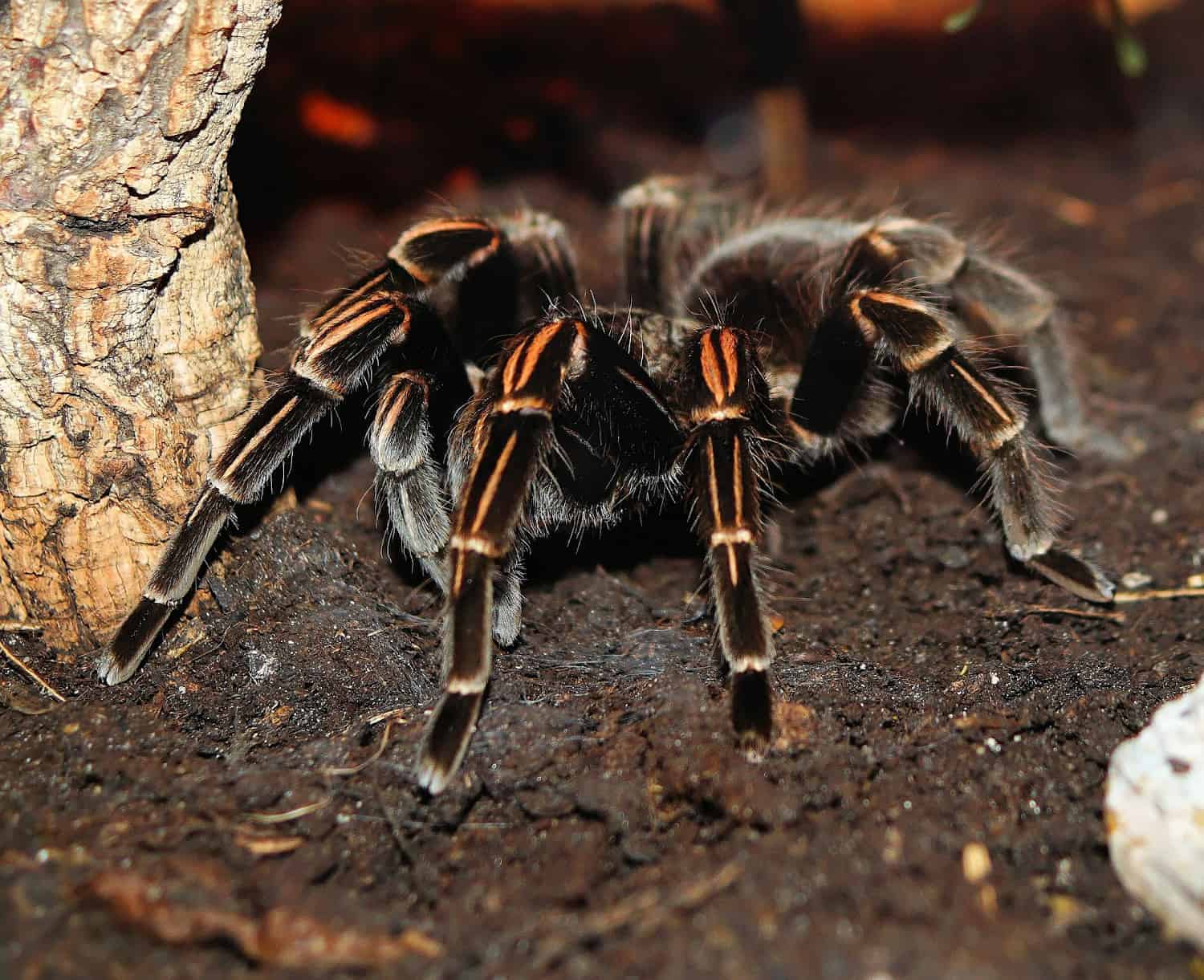
Ambient environment
Creating the perfect habitat and environment may be one of the more confusing topics. You need to keep tarantulas at the proper temperature and humidity. It is not that difficult, actually, to create a suitable environment for your spider. However, although there are always exceptions, the parameters discussed below can be applied for most of the tarantula species. Always research your chosen species on where they live in the wild. And even more important, also observe how your spider reacts to its environment.
Humidity
When you keep the humidity between 55% and 70%, it will be suitable for the majority of tarantulas. In most cases, a drinking bowl that is always filled with freshwater, and a cocos fibre substrate, will achieve the humidity for your spider. Many arboreal tarantulas require a bit higher humidity, more likely in the 70% to 85% range.
We already talked about how the substrate affects the humidity of the enclosure. Using a deeper layer of a substrate will keep the humidity balanced for a longer time. Adding vermiculite or sand to the substrate will change the humidity characteristics of the substrate.
If you need higher humidity, you can also add sphagnum moss to the enclosure. As sphagnum moss holds moisture, it will keep the humidity up. Alternatively, you can spray the substrate once in a while to keep it damp. Always spray mildly and not make it (soaked) wet. Never spray directly on your tarantula. Not only does a tarantula dislike being sprayed onto and consequently make it unhappy, angry and defensive. It also makes the openings to its book lungs wet and interferes with its breathing!
The ventilation capacity of your enclosure will affect the humidity. When have cross-ventilation with large ventilation holes, the humidity will quickly vanish out of the enclosure and speed up the evaporation process.
You can learn much by looking at your spider to check if the humidity is adequate. Terrestrial tarantulas will climb if they think the substrate is too wet. A tarantula that spends much time around or in its drinking bowl shows that it may require higher humidity and that the current condition is too dry. Pay attention to the behaviour of your spider and take action accordingly.
ATTENTION: Species with higher humidity requirements have more potential to grow mould in its enclosure. A warm and damp substrate is the ultimate soil for mould growth. Be conscious that these enclosures may need more frequent substrate refreshments.
Temperature and heating
As you can read almost everywhere, room temperature is just fine for tarantulas. And it is true, in most cases. However, to immediately clarify the discussion about what room temperature is, and that comfortable room temperature can be different for every person: A good temperature range for tarantulas is between 21°C and 26°C (70°F and 80°F). Need to panic when it gets to 20°C (69°F)? No! Temperature is usually not much of an issue (at least not in the summer and if not placed in direct sunlight), and tarantulas are far more resilient to temperature range than we think they are.
Tarantulas adapt their metabolism according to the temperature. With lower temperatures, it will eat less, and the metabolism will slow down. Usually, when the temperature rises, it will resume in their regular activity and also its eating habit. Another behaviour that can occur relating to the temperature is that a tarantula may burrow when it gets too cold or too hot and in this way will regulate its own temperature within an acceptable temperature range.
When the temperature rises above 32°C (90°F) it may give problems, so try to avoid such higher temperatures because it is not needed, for example, with heating. Additional heating is, in many cases, not necessary. If you placed a tarantula in a room that never reaches 18°C (65°F) or above, you may need to use additional heating, or change the location of the enclosure to a place where it will reach higher temperatures. Additional heating is sometimes also necessary during winter, although keeping your spider for some time at lower temperatures is not by definition a bad thing. Only be prepared that it will be less active and will eat less or not at all.
When you want to use a heat source for your enclosure, it would be best to use a small heat mat (with or without a thermostat, better would be with a thermostat) or with a space heater. A space heater works very well to maintain a base temperature of 21°C (70°F). When using a heat mat (also called a heating pad) only heat the enclosure half to prevent overheating and to prevent the enclosure from drying out. With a heat mat, you can warm only one (back)side or place only half of the enclosure on the heat mat.
Lighting
Tarantulas don’t need any additional lighting. In fact, they prefer to have a dark(er) place in the room. Whatever light that is in the room during daytime is enough for your tarantula, plus, additional lighting can be particularly bad for them, for example, by overheating or drying out the enclosure. Tarantulas have very poor eyesight, so it does not matter that there is not much light. And final, as said before, and I can’t say it enough, never place your tarantula enclosure into direct sunlight. Direct sunlight will surely cause overheating inside your enclosure.
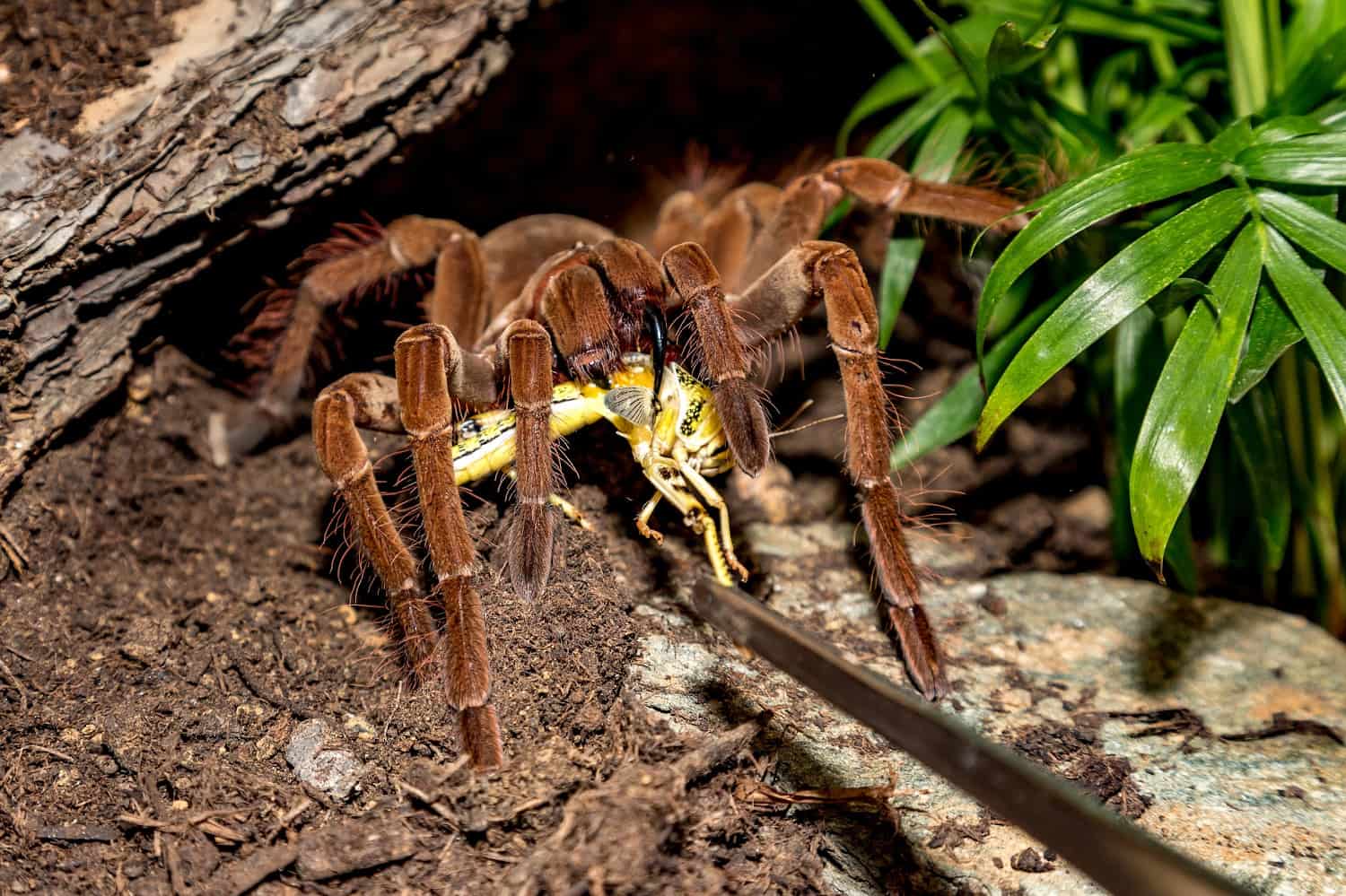
Feeding a tarantula
All tarantulas are predators, and their diet consists of insects such as crickets, cockroaches and locusts. You can also feed them mealworms and superworms — however, these items are very high in fat. You better use this as a treat once in a while.
A typical adult tarantula eats around four crickets a week. However, this amount may vary depending on the species, age, life stage, and sex. Sling and juvenile spiders, for example, will eat much more often than an adult. Some species have a general good appetite and will eat more, and others are more known to refuse food once in a while and eat less frequently. In general, you may feed your tarantula once or twice a week.
Make sure you don’t overfeed your tarantula, just observe your spider’s feeding habits and body condition of your spider. Feeding a tarantula is more based on feeling and experience than on simple numbers. Practically speaking it is not really possible to overfeed a tarantula, it simply won’t eat if it is not hungry. But some tarantulas have known to eat so much it will grow too large in a short time, which is unhealthy or give problems in the long term.
Tarantulas can go without food for several days, weeks or even months. It is quite usual for spiders to stop eating for longer periods of time. You do not immediately have to worry. To give more insight into how much your tarantula eats you should log the food intake. You can do this with a simple piece of a paper, notebook, or write it with a whiteboard marker on the enclosure (when you’ll use a whiteboard marker you can easily remove it again with disinfectant). Write down when you fed it, what you fed it and if your spider accepted the food. You can use simple code and abbreviations to do so: 17/9 2x CR or 22/9 R — which means on the 17th of September it ate two crickets or on the 22nd of September it refused to eat.
Feeding tarantulas is quite easy. But, don’t use your hands to feed them; otherwise, your spider will bite your finger instead of the prey. Use long feeder tongs/tweezers instead (of at least 20cm (8″) in length). Place or drop the insect near your tarantula. If you know your tarantula has a good appetite you can also just drop the insect in the enclosure, so your tarantula can hunt it. However, make sure your spider will catch the prey eventually. Always remove (parts of) uneaten prey at least within 24 hours.
Feeding insects need to be nutritious and healthy before you feed them. Read here about the general care of feeder insects. You can buy feeder insects online or at many pet stores. Would you like to breed your own feeder insects? Check out these pages on how to breed crickets or breed dubia roaches.
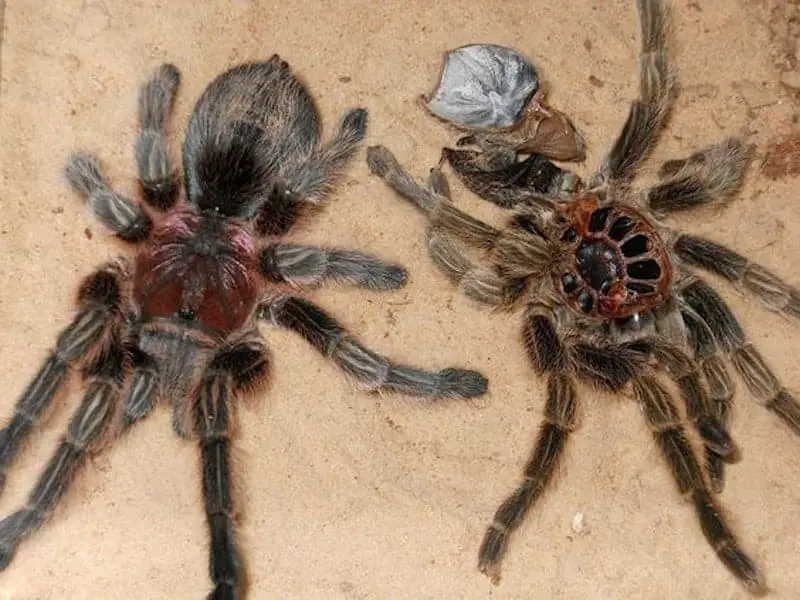
Moulting
Tarantulas will stop accept food a couple of days before moulting (pre-moult) and should not be fed during this time. Any uneaten live prey should be removed. They can also become less active, excessively webbing or make a den/bury themselves. Tarantulas are known to make a moulting web — a kind of mat or bed made out of web where the moulting process takes place on. Moulting is a normal process for tarantulas and takes place to be able to grow.
The tarantula will lie on its back. Many beginners have mistaken this event of that their spider is dying. And I must admit that the sight of your tarantula lying on its back looks pretty alarming if you don’t know what is happening.
Make sure the drinking bowl is full of fresh water. Not that a tarantula will drink during the moulting process, but it helps to keep or even increase the humidity a little to assist in the moulting process.
The moulting process itself can take up to one or two hours. The old exoskeleton will break open, and a brighter soft spider emerges from its old ‘body’. Moulting will almost always occur at night, but if you have the luck of witnessing it, never disturb the tarantula during the moult or pre-moult process. The tarantula is at its weakest and most vulnerable during this process, and disturbing it can cause many problems.
Cleaning
Tarantulas are quite tidy animals. Although some have the habit of throwing dirt everywhere or use their water bowl as a toilet, it generally takes not much time to clean the enclosure. However, good preparation is recommended, and this section will make clear of what cleaning tarantula enclosures include.
Oftentimes, spot cleaning is enough to get the dirt out. This type of cleaning includes collecting excrement, wiping dirt spots off the walls, remove old moults or uneaten prey items (or parts of it).
Every six months or so, you’ll need to do a full cleaning session unless it is filthy before then. This type of cleaning includes the removal of the substrate and disinfect the enclosure. While spot cleaning can often be done in the presence of your spider, full cleaning means that you’ll need to remove your tarantula to another (temporary) enclosure. That is where the backup enclosure, as talked about before, comes in.
When placing your tarantula back in the enclosure, after refreshing it, it can be a bit stressful for them. Tarantulas can be quite nervous when placed in a new and fresh environment. Tarantulas don’t like change. Be aware that it can be defensive, and even after a few days, you can still notice it needs to acclimate again. Just give it some time and peace to do so.

Handling and moving
Handling tarantulas — some people use their hands, and others do it with small plastic containers — it all depends on what is comfortable for you. Because when you feel comfortable with handling your spider, it is also much safer and less stressful for them.
Because the reality is that tarantulas don’t like being handled. Some tolerate it better than other spiders, but none of the tarantulas gets the pleasure of being picked up — as many cats, dogs and birds do. If you want to cuddle and handle your pet, choose something else than a tarantula!
Be aware of the risks — if you handle them with your hands or with a container — all tarantulas have fangs and can bite, have venom and can flick bristles that can irritate or cause a rash. And these defence mechanisms are at most risk of being used when handled or moved to another place. And you’ll need to be even more cautious with tarantulas from the ‘Old World’ because they have more prominent fangs, have more potent venom and tend to be much faster.
ATTENTION: Never hold an enclosure/tank onto its handles or lid. You’ll not only be very sorry if these parts break loose, but it will definitely injure, maybe even kill your beloved tarantula.
Species-specific care guides
Although this page provides extensive information on the general care of tarantulas, every species has its own specific needs and differs in behaviour, temperament and care. You should also research the specifics of the species you are keeping or want to keep. On this website, I put care sheets for different species.
Share this page!
